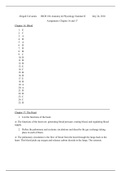Exam (elaborations)
BIOS 104 Anatomy & Physiology Summer II
- Course
- Nursing (BIOS104)
- Institution
- Thompson River University (TRU )
1. List the functions of the heart. A: The functions of the heart are: generating blood pressure, routing blood, and regulating blood supply. 2. Define the pulmonary and systemic circulations and describe the gas exchange taking place in each of them. A: The pulmonary circulation is the flow of...
[Show more]



